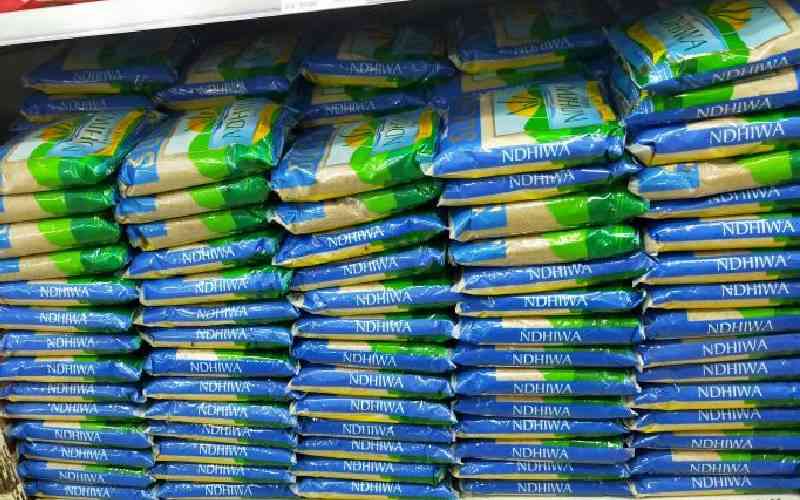By James Anyanzwa and John Njiraini
Toward the end of last year, a number of countries engaged in an unprecedented 'international currency war' in desperate measures to promote economic competitiveness.
From developed nations like Japan and stable economies like Switzerland, Brazil and South Korea to struggling economies like Cuba and Colombia, monetary authorities engaged in predatory tendencies of current manipulation to achieve a comparative advantage in terms of trade.
Others, like the US, went to the extent of taking measures like quantitative easing (a polite term for printing money) to purchase bonds, while China has been engaged in devaluing the Yuan against the US Dollar to make its exports to the world’s economic super power cheaper.
The so-called international currency war has now been put into the backburner with immediate challenges like rising crude oil prices and soaring inflation taking its place.
But there is no doubt it left a major dent on the exchange rates and created significant distortions in the global financial exchange markets, including Kenya’s emerging money market.
Though Kenya, heavily dependent on imports, was considered insignificant to participate in the ‘war’, the country is today suffering from the ripple effects and is feeling the pain of the distortion, with its currency sovereignty being made worse by the unrest in the Arab world and the Central Bank of Kenya (CBK) maintaining market forces must be left to determine the fate of the shilling.
Sharp fall
Over the past eight months, from September last year when the currency war was at its peak, the shilling has weakened against the US dollar from Sh80 to a 17-year low of Sh86.55 mid last week. The sharp fall was witnessed immediately after the CBK Governor Njuguna Ndung’u ruled out the possibility of intervention.
While by Friday last week it had gained some ground to close the week at Sh84.55 against the dollar, the big question is why the CBK felt intervening was imprudent?
Considering that Kenya was a victim of external forces, many wonder if the CBK acted cowardly in failing to arrest further decline in guise that Kenya is a free market.
But even as CBK shows no signs of intervening, manufacturers have warned of further increases in commodity prices as the shilling exchange rate falls to its lowest level ever.
It will be interesting to watch what tricks Ndung’u and the Monetary Policy Committee have up their sleeves in the coming months in taming inflation.
The overwhelming evidence is that CBK’s non-interventionist approach spells doom. It has made the economy weaker; it basically lost the economic recovery momentum that was widely expected to hit six per cent come June this year.
There are high levels of anxiety in the country. Though it’s too early to know the extent of damage on the economy, indications are that things do not look better in the economic front.
Amid all the bullish statistics about growth, commodity prices and the exchange rate, there is one statistic, which is extremely disturbing for the long-term health of the nation — the surge in inflation rate.
All economic indications are pointing to the negative —weakening shilling, forecast drought and the anticipated rise in oil prices—all of which point to a possible general increase in the price of commodities.
The fear is in such a trend may be accompanied by the ever quick-to-act financial institutions taking on the same and increasing their interest rates, which not good news for the overall economic growth.
Already, a steep surge in food and petroleum prices pushed inflation in March to its highest level since the new way to calculate inflation was introduced.
The inflation rate climbed to 6.54 per cent in February, the highest since October 2009, from 5.4 per cent a month earlier, according to the Kenya National Bureau of Statistics. Prices rose 1.3 per cent in the month.
Then it emerged — on the back of prediction of the weatherman —household budgets could tighten further in the coming months of depressed and poorly distributed rainfall that could dent food and energy production for several months to come.
Some key stakeholders in the Kenyan economy such as manufacturers, packaging entrepreneurs and business practitioners have voiced concerns over the rising cost of inputs fuelled by fragile currency and a surge in crude oil prices.
High crude oil prices pushed up by spiralling civil unrest in the Arab world, local political animosity and reduced tea exports are causing the shilling to lose ground against the US dollar.
This is happening when the crisis in the Northern parts of Africa (Egypt, Tunisia and Libya) and the Middle East is causing an upward movement in fuel prices while providing side shocks on cost of living index.
Predictable currency
Mr Paul Melly, the Standard Group’s Deputy Chairman and Chief Strategist observed that the weakening of the shilling is certainly a major threat to business.
"There is no Central Bank that does not intervene. The monetary authority should not allow the shilling to lose further ground," Melly said last week, adding that a weak shilling is impacting on the importation of newsprint.
"We need a predictable currency for working capital in terms of imports," he said.
Also of huge concern is the rising price of oil, which is exerting inflationary pressures.
It is feared that the rising cost of living could impact on turnovers by reducing households’ disposable income.
Similar sentiments were shared by the Kenya Association of Manufacturers (KAM), which said the weakening of the shilling has pushed up the cost of production by seven per cent.
Mr Jaswinder Bedi, the association’s chairman said the worrying situation has been exasperated by the skyrocketing fuel prices, which have jointly affected the price of raw materials and pushed up the cost of inputs.
"Kenyans will be affected by the double impact of an increase in oil price and the weakening of the shilling which have inflationary pressures," Bedi told Financial Journal.
Consequently, manufacturers are now thinking of how to pass on the increased cost of production to consumers through an upward revision in commodity prices.
"There will be some cushioning that the industry will do. There will be an upward increase in the prices of commodities," said Bedi.
Kenya Tea Packers Ltd (Ketepa) has already warned of a price increase for its products. The firm reckons that their production costs have gone with imports of packaging materials increasing in tandem with the depreciating shilling.
"All the purchases we make like most of our packages are based on the dollar. So our import costs have just shot up in a way that is unbelievable thereby affecting our profitability," said Tim Chege, the company’s managing director.
"Our costs are going up and business going down and that is why we are appealing to the government to see a way of stabilising that."
While the stakeholders have called on the government to stabilise the falling shilling central bank still maintains it will stay out of the market at least for the moment.
But the bank’s comments did not do any good to the market as the shilling reacted negatively plunging to Sh86 against the US dollar on Monday last week, the lowest ever in 17 years.
But despite the cry of foul play, a depreciating shilling, however, stimulates the country’s export and tourism sectors.
Kenya’s exports in the international market become cheaper and more competitive, while tourists find Kenya a cheaper destination.
However, the growth in import costs is expected to increase in production costs, cause inflationary pressures and subsequently an upward pressure on interest rates.
"A weak shilling is good for tourism and our exports. The only thing to do is to contain the cost of production and the cost of doing business," Mr Najib Balala, the Minister for Tourism told the Financial Journal in a telephone interview from Moscow.
"Let us be clear on what we want. Do we want a market driven and open economy or a regulated economy."
In deed if the Japanese central bank could engage in a massive sale of yen to buy dollars with the aim of weakening the yen’s value against the dollar to make her exports cheaper, why couldn’t the CBK ease the pain on Kenyan importers?
As the shilling continued to depreciate, CBK Governor Prof Njuguna Ndung’u sole explanation was that intervening would instigate speculation.
"If the CBK were to try to protect the shilling, it would signal that the country was exposing itself to a speculative attack on its foreign reserves," explained Prof Ndung’u.
He added that the economic fundamentals of the country had not changed and remain healthy, hence the economy should, as it has in the past, ride out of the temporary volatilities.
Granted, finding the right equilibrium for the shilling is never an easy task due to export and import related forces pulling in different directions, with each seeking to benefit from either a weak or strong shilling.
While the current scenario whereby the local currency continues on a sliding course, it poses risk to the country’s macroeconomic stability even though the country runs a managed floating exchange rate regime that has inbuilt capacity to smoothen out any unwarranted exchange rate fluctuations.
But whether the CBK should intervene in the market still remains a big topic for discussion.
A managed currency is an exchange rate that is basically floating in the foreign exchange markets, but is subject to intervention from time to time by the monetary authorities, in order to resist fluctuations that they consider to be undesirable.
The International Monetary Fund (IMF) said it will provide support if the pressure on the shilling exchange rate become excessive.
Undue pressure
"We believe CBK is in control of the situation. The flexible exchange rate is an appropriate response to pressure on the shilling," said Ragnar Gudmundsson, IMF Resident Representative in Kenya.
"We will provide support if pressure on the shilling is excessive. Otherwise we believe CBK’s non-intervention stance is appropriate."
Normally, Central Bank intervenes to stabilise the exchange rate by buying and selling domestic and foreign currencies.
Up to 1974, the exchange rate for the shilling was pegged to the US dollar, but after discrete devaluations the peg was changed to the Special Drawing Rate (SDR).
Between 1974 and 1981 the movement of the nominal exchange rate relative to the dollar was erratic. In general the rate depreciated by about 14 per cent and this depreciation accelerated in 1981/82 with further devaluations.
The exchange rate regime was changed to a crawling peg in real terms at the end of 1982.
This regime was in place until 1990 when a dual exchange rate system was then adopted that lasted until October 1993.
After further devaluations, the official exchange rate was abolished by merging it with the market rate. This marked the switch to a floating exchange rate.
 The Standard Group Plc is a multi-media organization with investments in media
platforms spanning newspaper print operations, television, radio broadcasting,
digital and online services. The Standard Group is recognized as a leading
multi-media house in Kenya with a key influence in matters of national and
international interest.
The Standard Group Plc is a multi-media organization with investments in media
platforms spanning newspaper print operations, television, radio broadcasting,
digital and online services. The Standard Group is recognized as a leading
multi-media house in Kenya with a key influence in matters of national and
international interest.
 The Standard Group Plc is a multi-media organization with investments in media
platforms spanning newspaper print operations, television, radio broadcasting,
digital and online services. The Standard Group is recognized as a leading
multi-media house in Kenya with a key influence in matters of national and
international interest.
The Standard Group Plc is a multi-media organization with investments in media
platforms spanning newspaper print operations, television, radio broadcasting,
digital and online services. The Standard Group is recognized as a leading
multi-media house in Kenya with a key influence in matters of national and
international interest.









